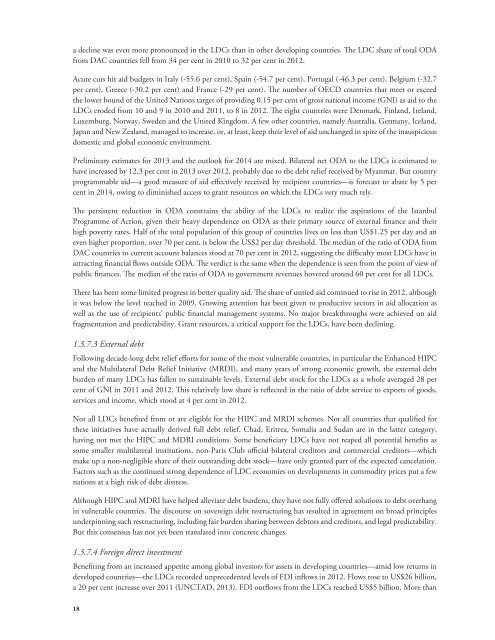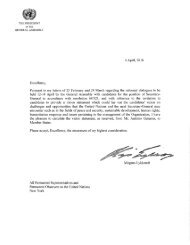State-of-the-Least-Developed-Countries-Report-2014
State-of-the-Least-Developed-Countries-Report-2014
State-of-the-Least-Developed-Countries-Report-2014
Create successful ePaper yourself
Turn your PDF publications into a flip-book with our unique Google optimized e-Paper software.
a decline was even more pronounced in <strong>the</strong> LDCs than in o<strong>the</strong>r developing countries. The LDC share <strong>of</strong> total ODA<br />
from DAC countries fell from 34 per cent in 2010 to 32 per cent in 2012.<br />
Acute cuts hit aid budgets in Italy (-55.6 per cent), Spain (-54.7 per cent), Portugal (-46.3 per cent), Belgium (-32.7<br />
per cent), Greece (-30.2 per cent) and France (-29 per cent). The number <strong>of</strong> OECD countries that meet or exceed<br />
<strong>the</strong> lower bound <strong>of</strong> <strong>the</strong> United Nations target <strong>of</strong> providing 0.15 per cent <strong>of</strong> gross national income (GNI) as aid to <strong>the</strong><br />
LDCs eroded from 10 and 9 in 2010 and 2011, to 8 in 2012. The eight countries were Denmark, Finland, Ireland,<br />
Luxemburg, Norway, Sweden and <strong>the</strong> United Kingdom. A few o<strong>the</strong>r countries, namely Australia, Germany, Iceland,<br />
Japan and New Zealand, managed to increase, or, at least, keep <strong>the</strong>ir level <strong>of</strong> aid unchanged in spite <strong>of</strong> <strong>the</strong> inauspicious<br />
domestic and global economic environment.<br />
Preliminary estimates for 2013 and <strong>the</strong> outlook for <strong>2014</strong> are mixed. Bilateral net ODA to <strong>the</strong> LDCs is estimated to<br />
have increased by 12.3 per cent in 2013 over 2012, probably due to <strong>the</strong> debt relief received by Myanmar. But country<br />
programmable aid—a good measure <strong>of</strong> aid effectively received by recipient countries—is forecast to abate by 5 per<br />
cent in <strong>2014</strong>, owing to diminished access to grant resources on which <strong>the</strong> LDCs very much rely.<br />
The persistent reduction in ODA constrains <strong>the</strong> ability <strong>of</strong> <strong>the</strong> LDCs to realize <strong>the</strong> aspirations <strong>of</strong> <strong>the</strong> Istanbul<br />
Programme <strong>of</strong> Action, given <strong>the</strong>ir heavy dependence on ODA as <strong>the</strong>ir primary source <strong>of</strong> external finance and <strong>the</strong>ir<br />
high poverty rates. Half <strong>of</strong> <strong>the</strong> total population <strong>of</strong> this group <strong>of</strong> countries lives on less than US$1.25 per day and an<br />
even higher proportion, over 70 per cent, is below <strong>the</strong> US$2 per day threshold. The median <strong>of</strong> <strong>the</strong> ratio <strong>of</strong> ODA from<br />
DAC countries to current account balances stood at 70 per cent in 2012, suggesting <strong>the</strong> difficulty most LDCs have in<br />
attracting financial flows outside ODA. The verdict is <strong>the</strong> same when <strong>the</strong> dependence is seen from <strong>the</strong> point <strong>of</strong> view <strong>of</strong><br />
public finances. The median <strong>of</strong> <strong>the</strong> ratio <strong>of</strong> ODA to government revenues hovered around 60 per cent for all LDCs.<br />
There has been some limited progress in better quality aid. The share <strong>of</strong> untied aid continued to rise in 2012, although<br />
it was below <strong>the</strong> level reached in 2009. Growing attention has been given to productive sectors in aid allocation as<br />
well as <strong>the</strong> use <strong>of</strong> recipients’ public financial management systems. No major breakthroughs were achieved on aid<br />
fragmentation and predictability. Grant resources, a critical support for <strong>the</strong> LDCs, have been declining.<br />
1.3.7.3 External debt<br />
Following decade-long debt relief efforts for some <strong>of</strong> <strong>the</strong> most vulnerable countries, in particular <strong>the</strong> Enhanced HIPC<br />
and <strong>the</strong> Multilateral Debt Relief Initiative (MRDI), and many years <strong>of</strong> strong economic growth, <strong>the</strong> external debt<br />
burden <strong>of</strong> many LDCs has fallen to sustainable levels. External debt stock for <strong>the</strong> LDCs as a whole averaged 28 per<br />
cent <strong>of</strong> GNI in 2011 and 2012. This relatively low share is reflected in <strong>the</strong> ratio <strong>of</strong> debt service to exports <strong>of</strong> goods,<br />
services and income, which stood at 4 per cent in 2012.<br />
Not all LDCs benefited from or are eligible for <strong>the</strong> HIPC and MRDI schemes. Not all countries that qualified for<br />
<strong>the</strong>se initiatives have actually derived full debt relief. Chad, Eritrea, Somalia and Sudan are in <strong>the</strong> latter category,<br />
having not met <strong>the</strong> HIPC and MDRI conditions. Some beneficiary LDCs have not reaped all potential benefits as<br />
some smaller multilateral institutions, non-Paris Club <strong>of</strong>ficial bilateral creditors and commercial creditors—which<br />
make up a non-negligible share <strong>of</strong> <strong>the</strong>ir outstanding debt stock—have only granted part <strong>of</strong> <strong>the</strong> expected cancelation.<br />
Factors such as <strong>the</strong> continued strong dependence <strong>of</strong> LDC economies on developments in commodity prices put a few<br />
nations at a high risk <strong>of</strong> debt distress.<br />
Although HIPC and MDRI have helped alleviate debt burdens, <strong>the</strong>y have not fully <strong>of</strong>fered solutions to debt overhang<br />
in vulnerable countries. The discourse on sovereign debt restructuring has resulted in agreement on broad principles<br />
underpinning such restructuring, including fair burden sharing between debtors and creditors, and legal predictability.<br />
But this consensus has not yet been translated into concrete changes.<br />
1.3.7.4 Foreign direct investment<br />
Benefiting from an increased appetite among global investors for assets in developing countries—amid low returns in<br />
developed countries—<strong>the</strong> LDCs recorded unprecedented levels <strong>of</strong> FDI inflows in 2012. Flows rose to US$26 billion,<br />
a 20 per cent increase over 2011 (UNCTAD, 2013). FDI outflows from <strong>the</strong> LDCs reached US$5 billion. More than<br />
18



